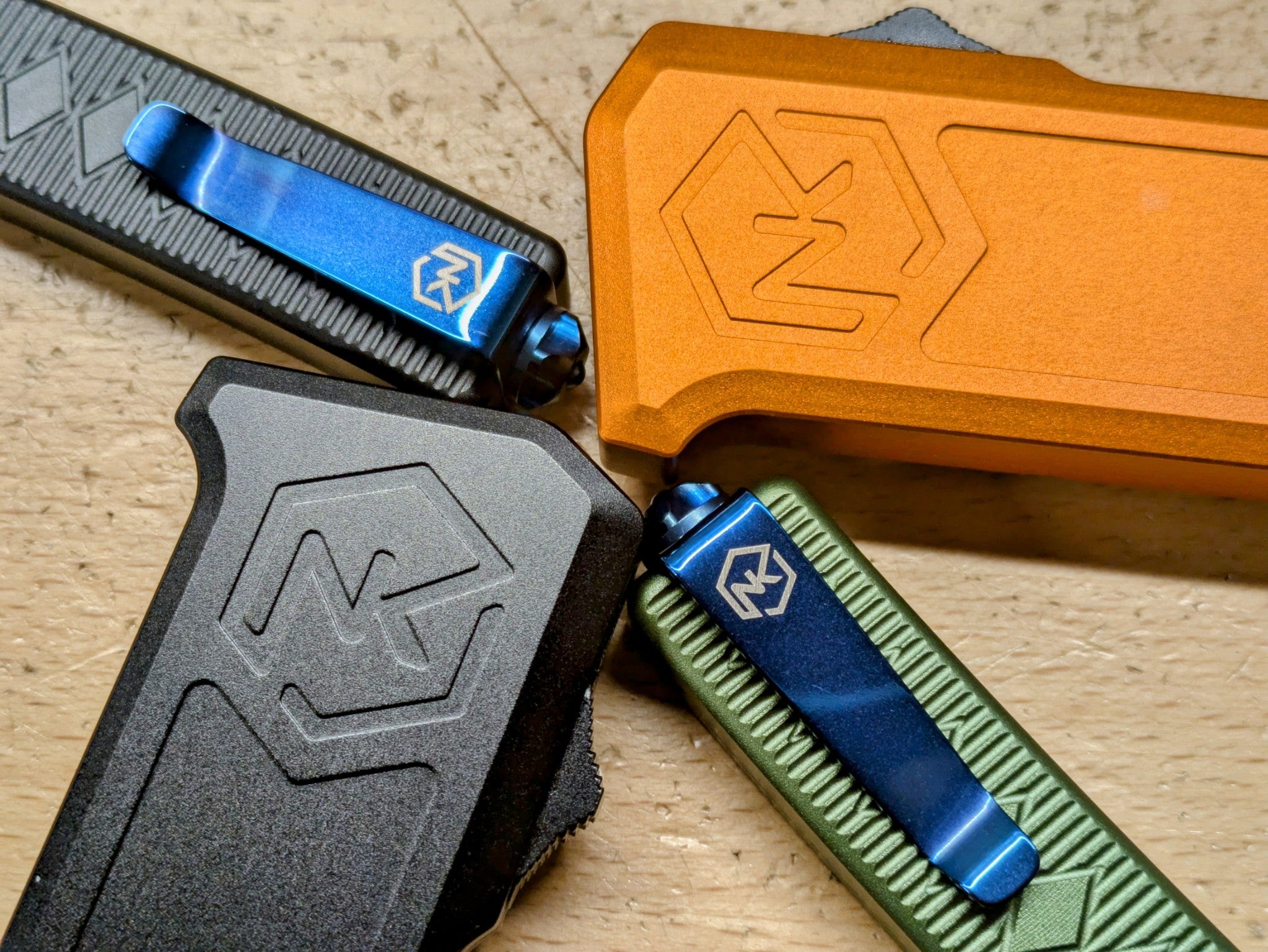How does an OTF Knife work?
Each Knife has two spring gates and a center spring-loaded slide bar that extends and retracts the blade. Once the blade has been activated, there is nothing but inertia sending the blade in either direction. This means that if there are obstacles inside or outside the knife that interrupt this travel, the blade will come to a stop. At this point, the knife needs to be reset to resume normal operation.
My OTF isn't working
Are you aware of the failsafe mechanism on our OTF knives? All Normandy Knives are equipped with a fail-safe mechanism to ensure safety and preserve the internals of the knife. If your blade encounters any resistance during deployment, the blade will automatically disengage itself from the internal spring assembly and slide loosely within the handle of the knife. To reset the knife, carefully pinch the blade between your thumb and index finger and pull the blade out of the handle until it locks in the fully deployed position. The knife will then resume normal operation.
If your OTF knife fails to deploy properly, it's most likely caused by dirt, debris, or other buildup within the handle of the knife. If the internals of your knife are dry, this may also contribute to issues with deployment. See below for detailed instructions on how to clean and care for your OTF knife. If your OTF knife still doesn't function properly after cleaning and lubricating the internals, please visit our warranty page to arrange to have your knife sent in for service.
Cleaning OTF Knives
Properly maintaining your Normandy knife will help ensure a lifetime of reliable performance. Follow the recommended instructions below for cleaning and caring for your OTF knife. We recommend using NK OTF Knife Care Oil to clean, protect, and lubricate your OTF knives. You can also use a very light gun oil such as REM Oil. Do not use WD-40 or any low viscosity oil as that will attract dirt and debris.
Routine Maintenance
- Tilt your OTF knife upside down and blow compressed air into the opening to remove any dirt, buildup, and/or debris.
- Apply Knife Care Oil into the opening of your knife. Deploy and retract the blade several times to ensure that all of the internal components are well lubricated.
- Tilt your knife upside down again and blow compressed air into the opening to remove any excess oil. It is important to keep your knife well lubricated, but too much lubrication can attract dirt and build-up and hinder the performance of your knife.
- Finally, place a drop of Knife Care Oil on each side of the trigger area of your blade to keep the action of your knife functioning smoothly and efficiently.
TO PREVENT RUST from building up on your blade, keep your knife well-lubricated and clean from debris. If you are using your knife to cut through tape, we recommend removing any tape residue from the blade before retracting it back into the handle.
Lubrication for Cleaning
When cleaning your OTF knife, it's important to use a lubricant to protect the blade and prevent corrosion. Avoid any oils or lubricants that are low viscosity like WD-40. Only use high viscosity "gun safe" lubricants. For best results use NK OTF Knife Care Oil. Apply a few drops of oil to a clean cloth and wipe down the blade, paying special attention to the pivot point and any moving parts.
Disassembly
We take a different approach then traditional knife manufacturers, recognizing that many of you prefer to maintain your own knives. We don't use proprietary screws on our knives. We don't void your warranty if you disassemble your knife. We advise against excessive disassembly of your knife because it can put unnecessary wear and tear on parts, but periodic disassembly may be required in order to keep your knife running at the highest level.
Shoguns use a T2 screw
Small and Medium Griffins and Crusaders use a T7 screw
Large Griffins and Crusaders use a T10 screw
Differences Between 440C Steel and D2 Steel
440C steel is a stainless steel known for its corrosion resistance and relative easy maintenance. It is commonly used in knife blades due to its good edge retention and toughness. On the other hand, D2 steel is a tool steel known for its excellent wear resistance and edge retention. It is harder to sharpen compared to 440C steel and requires more maintenance, but it can hold a sharp edge for longer periods of time.
Sharpening Different Blade Styles
Drop Point Blade
To sharpen a drop-point blade, place the blade edge against the sharpening stone at a 20 to 24-degree angle. Use consistent strokes in a sweeping motion, moving the blade from the base to the tip. Repeat the process until the blade is sharp, and then hone the blade with a leather strop to refine the edge.
Tanto Style Blade
To sharpen a tanto style blade, sharpen the straight edge of the blade first, following the same process as the drop point blade. Then, switch to the secondary bevel (the tanto edge) and sharpen it separately by laying the edge flat against the stone and making short, sweeping motions. Be careful not to round the tip of the tanto edge.
Spear Point Blade
Spear point blades have two symmetrical edges that converge to a point, so sharpening them is similar to sharpening a drop point blade. Hold the blade edge against the stone at the desired angle and use consistent strokes from the base to the tip. Flip the blade and repeat the process on the other side to maintain symmetry.
Proper care and maintenance are essential for keeping your OTF knife in optimal condition. Remember to follow the appropriate sharpening techniques for different blade styles, understand the differences between steel types, and use appropriate lubrication when cleaning to ensure a long-lasting and functional knife.



